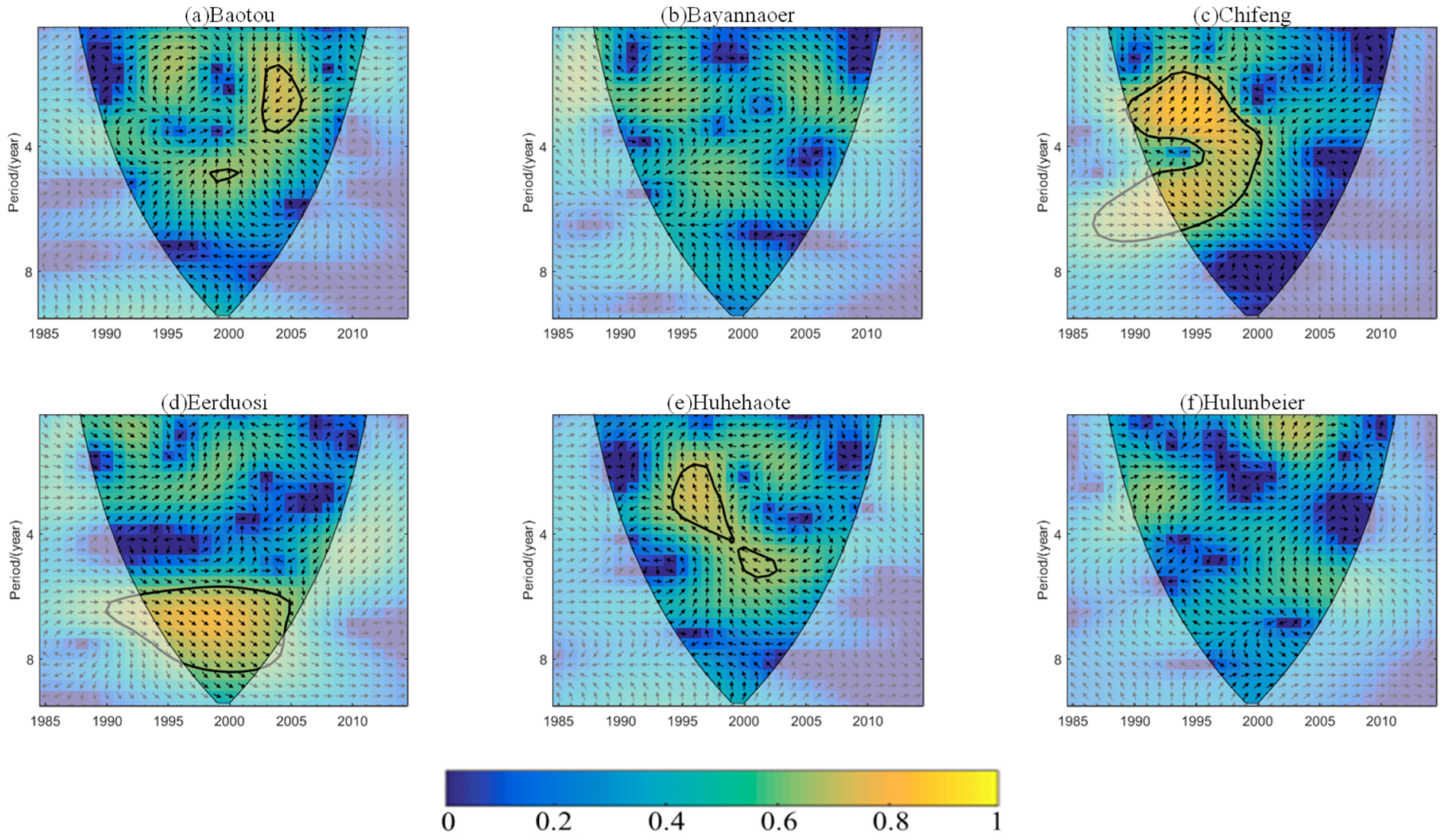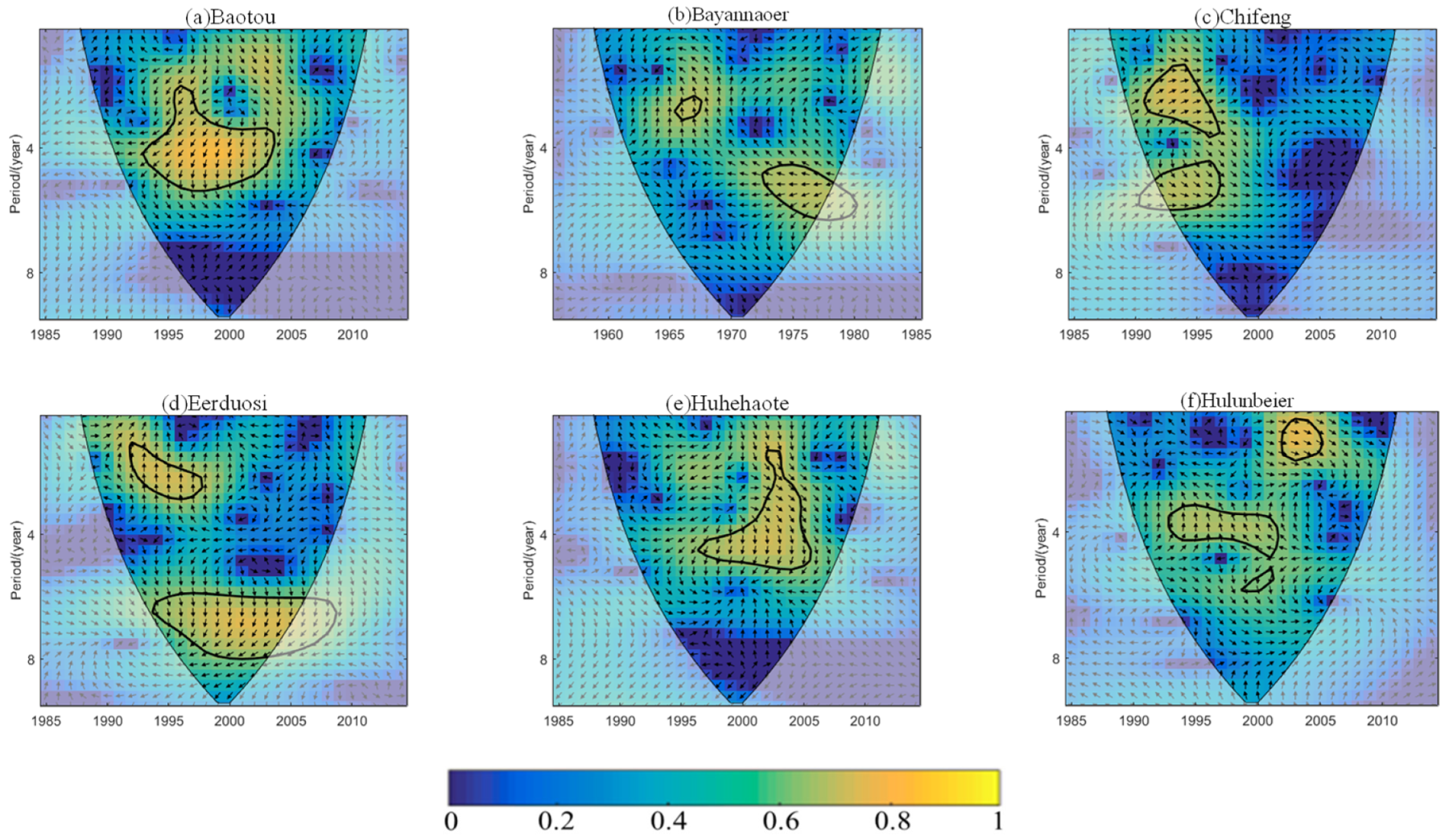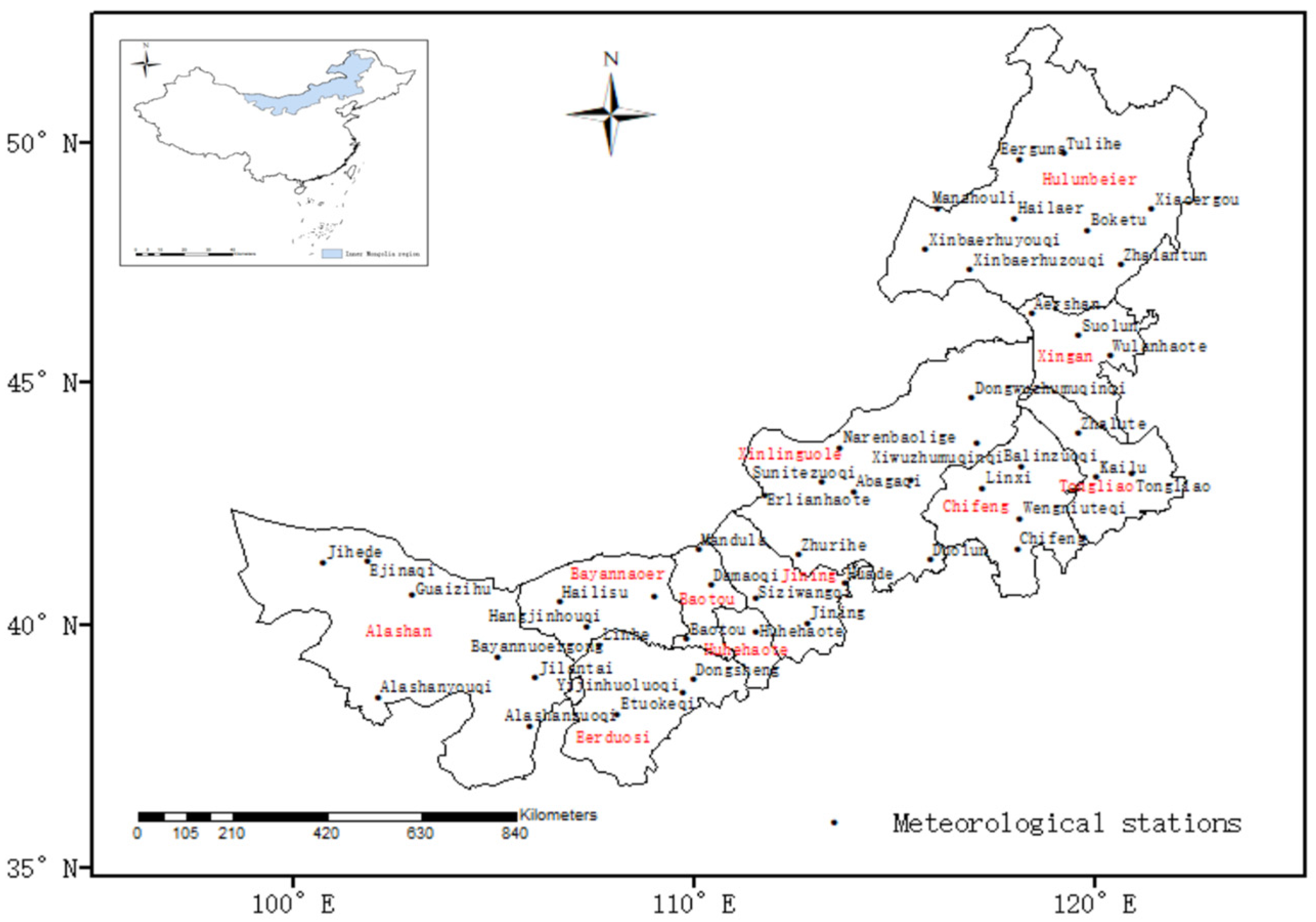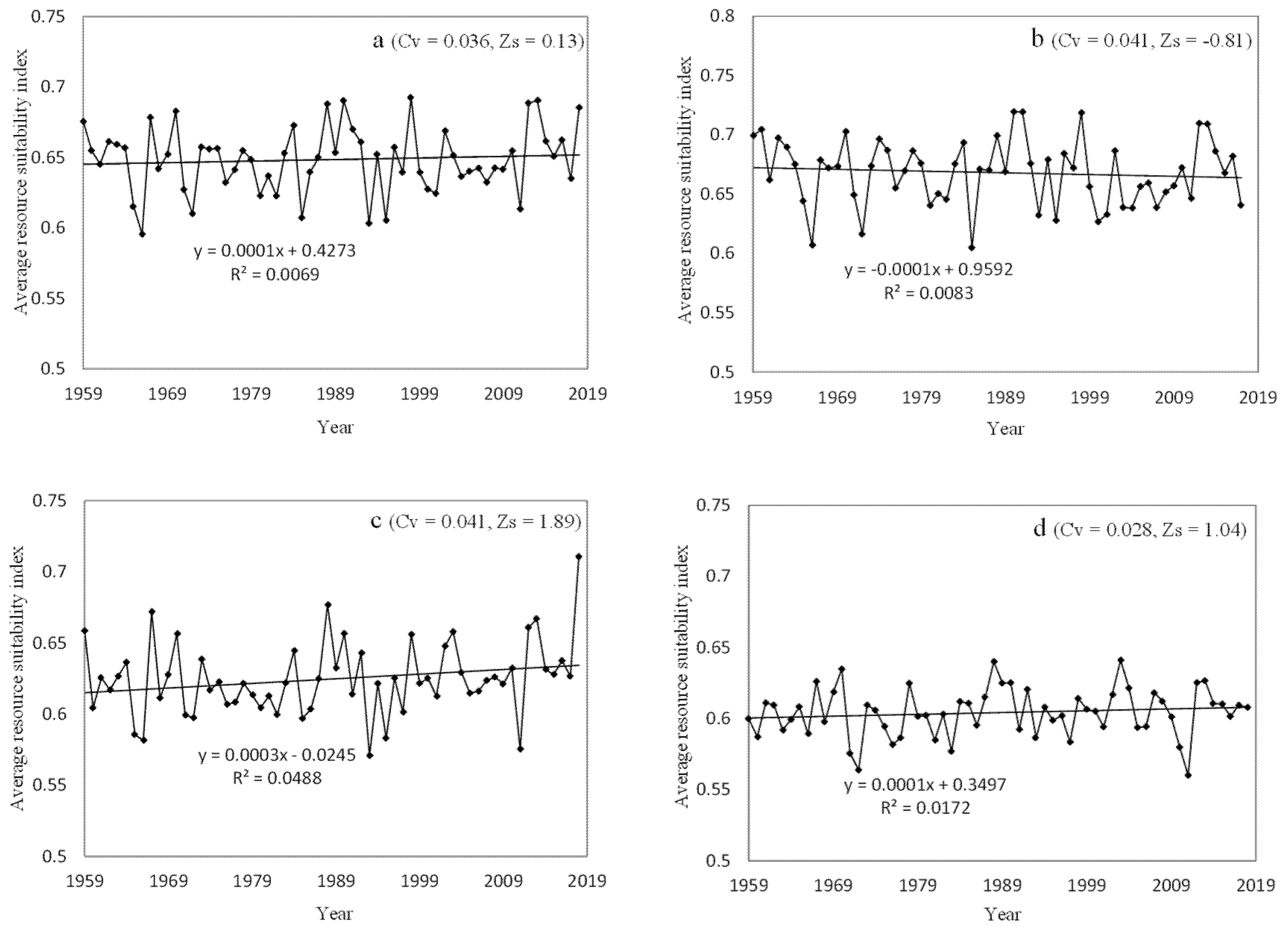Effects of Climate Change on Cultivation Patterns and Climate Suitability of Spring Maize in Inner Mongolia
Abstract
:1. Introduction
2. Materials and Methods
2.1. Study Area
2.2. Data
2.2.1. Meteorological Data
2.2.2. Crop Information
2.3. Research Methods
2.3.1. Classification of Different Spring Maize Varieties in Inner Mongolia
2.3.2. Identifying the Meterological Trends
2.3.3. Climate Suitability for Spring Maize Cultivation
- (i).
- Temperature suitability index
- (ii).
- Water suitability index
- (iii).
- Sunshine hours suitability index.
2.3.4. Crop Yield Separation
2.3.5. Wavelet Analysis
3. Results
3.1. Changes in Meteorological Elements
3.2. Temporal and Spatial Changes of Spring Maize Cultivation Patterns in Inner Mongolia
3.3. Changes in Climate Suitability of Spring Mazie Planting Areas in Inner Mongolia from 1959 to 2018
3.3.1. Temporal Changes in Climate Suitability
3.3.2. Spatial Changes in Climate Suitability
3.4. Relationship between Climate Suitability and Yield
3.5. XWT of Climate-Induced Yield and Climate Suitability
4. Discussion
5. Conclusions
Author Contributions
Funding
Institutional Review Board Statement
Informed Consent Statement
Data Availability Statement
Acknowledgments
Conflicts of Interest
Appendix A




References
- Moeletsi, M.E.; Moopisa, S.G.; Walker, S.; Tsubo, M. Development of an agroclimatological risk tool for dryland maize production in the Free State Province of South Africa. Comput. Electron. Agric. 2013, 95, 108–121. [Google Scholar] [CrossRef]
- IPCC. Climate Change 2014: Impacts, Adaptation, and Vulnerability; IPCC Working Group II: Bremen, Germany, 2014. [Google Scholar]
- Lal, R. Adaptation and mitigation of climate change by improving agriculture in India. In Climate Change and Agriculture in India. Impact and Adaptation; Springer: Cham, Switzerland, 2019; pp. 217–227. [Google Scholar]
- Abd-Elmabod, S.-K.; Muñoz-Rojas, M.; Jordán, A.; Anaya-Romero, M.; Phillips, J.-D.; Laurence, J.; de la Rosa, D. Climate change impacts on agricultural suitability and yield reduction in a Mediterranean region. Geoderma 2020, 374, 114453. [Google Scholar] [CrossRef]
- Tilman, D.; Cassman, K.G.; Matson, P.A.; Naylor, R.; Polasky, S. Agricultural sustainability and intensive production practices. Nature 2002, 418, 671–677. [Google Scholar] [CrossRef] [PubMed]
- Hanjra, M.A.; Qureshi, M.E. Global water crisis and future food security in an era of climate change. Food Policy 2010, 35, 365–377. [Google Scholar] [CrossRef]
- Poppy, G.M.; Chiotha, S.; Eigenbrod, F.; Harvey, C.A.; Honzák, M.; Hudson, M.D.; Villa, F. Food security in a perfect storm: Using the ecosystem services framework to increase understanding. Philos. Trans. R. Soc. B Biol. Sci. 2014, 369, 20120288. [Google Scholar] [CrossRef] [PubMed] [Green Version]
- Spinoni, J.; Naumann, G.; Vogt, J.; Barbosa, P. European drought climatologies and trends based on a multi-indicator approach. Glob. Planet. Chang. 2015, 127, 50–57. [Google Scholar] [CrossRef]
- Kontgis, C.; Schneider, A.; Ozdogan, M.; Kuchairk, C.; Tri, V.D.; Duc, N.H.; Schatz, J. Climate change impacts on rice productivity in the Mekong River Delta. Appl. Geogr. 2019, 102, 71–83. [Google Scholar] [CrossRef]
- Tong, S.Q.; Li, X.Q.; Zhang, J.Q.; Bao, Y.H.; Bao, Y.B.; Na, L.; Si, A.L. Spatial and temporal variability in extreme temperature and precipitation events in Inner Mongolia (China) during 1960–2017. Sci. Total Environ. 2019, 649, 75–89. [Google Scholar] [CrossRef]
- Wang, X.H.; Peng, L.Q.; Zhang, X.P.; Yin, G.D.; Zhao, C.; Piao, S.L. Divergence ofclimate impacts on maize yield in Northeast China. Agric. Ecosyst. Environ. 2014, 196, 51–58. [Google Scholar] [CrossRef]
- Aggarwal, P.; Vyas, S.; Thornton, P.; Campbell, B.M.; Kropff, M. Importance of considering technology growth in impact assessments of climate change on agriculture. Glob. Food Secur. 2019, 23, 41–48. [Google Scholar] [CrossRef]
- Holzkämper, A.; Calanca, P.; Fuhrer, J. Identifying climatic limitations to grain maize yield potentials using a suitability evaluation approach. Agric. For. Meteorol. 2013, 168, 149–159. [Google Scholar] [CrossRef]
- Kenny, G.J.; Ye, W.; Flux, T.; Warrick, R.A. Climate variations and New Zealand agriculture: The CLIMPACTS system and issues of spatial and temporal scale. Environ. Int. 2001, 27, 189–194. [Google Scholar] [CrossRef]
- Carter, T.R.; Parry, M.L.; Porter, J.H. Climatic change and future agroclimatic potential in Europe. Int. J. Climatol. 1991, 11, 251–269. [Google Scholar] [CrossRef]
- Dong, Z.; Pan, Z.; He, Q.; Wang, J.; Huang, L.; Pan, Y.; Chen, Y. Vulnerability assessment of spring wheat production to climate change in the Inner Mongolia region of China. Ecol. Indic. 2018, 85, 67–78. [Google Scholar] [CrossRef]
- Guo, Y.; Xiao, Y.; Li, C.; Gao, Y.; Jiang, X. Analysis on heat conditions of maize production in Tongliao. Meteorol. J. Inn. Mong. 2011, 3, 28–30. [Google Scholar]
- Tang, H.; Niu, B. Climate division of spring maize based on GIS technology in Xing’an League, Inner Mongolia. Chin. Agric. Sci. Bull. 2011, 25, 447–450. [Google Scholar]
- Lv, M. Gis-based precision zoning of heat resources for corn in Hulunbeier City from 1985 to 2014. Meteorol. J. Inn. Mong. 2017, 4, 37–40. [Google Scholar]
- Xiao, D. Changes of crop phenology in Inner Mongolia under the background of climate warming. Chin. Agric. Sci. Bull. 2015, 31, 216–221. [Google Scholar]
- Olesen, J.E.; Bindi, M. Consequences of climate change for European agricultural productivity, land use and policy. Eur. J. Agron. 2002, 16, 239–262. [Google Scholar] [CrossRef]
- Decker, W.L.; Jones, V.K.; Achutuni, R. Impact of Climate Change from Increased Atmospheric Carbon Dioxide on American Agriculture; (No. DOE/NBB-0077); Missouri University, Department of Atmospheric Science: Columbia, MO, USA, 1986. [Google Scholar]
- Liu, W.; Chen, H.; Yu, W.; Liu, Z. Dynamic output forecast research for winter wheat based on climatic suitability index. Meteorol. Environ. Sci. 2008, 31, 21–24. [Google Scholar]
- Sun, X.; Yan, W.; Wu, R.; Li, P. Simulation model for maize developmental stages in Hetao Irrigation Area based on climate suitability. Chin. J. Agrometeorol. 2014, 35, 62–67. [Google Scholar]
- Lobell, D.B.; Burke, M.B. The importance of temperature relative to precipitation. Environ. Res. Lett. 2008, 3, 034007. [Google Scholar] [CrossRef]
- Zhou, Z.; Shi, H.; Fu, Q.; Li, T.; Liu, S. Assessing spatiotemporal characteristics of drought and its effects on climate-induced yield of maize in northeast China. J. Hydrol. 2020, 588, 125097. [Google Scholar] [CrossRef]
- Ding, Y.; Wang, W.; Song, R.; Shao, Q.; Jiao, X.; Xing, W. Modeling spatial and temporal variability of the impact of climate change on rice irrigation water requirements in the middle and lower reaches of the Yangtze River, China. Agric. Water Manag. 2017, 193, 89–101. [Google Scholar] [CrossRef]
- Zhao, J.; Guo, J.; Mu, J. Exploring the relationships between climatic variables and climate-induced yield of spring maize in northeast China. Agric. Ecosyst. Environ. 2015, 207, 79–90. [Google Scholar] [CrossRef]
- Charlier, J.B.; Ladouche, B.; Maréchal, J.C. Identifying the impact of climate and anthropic pressures on karst aquifers using wavelet analysis. J. Hydrol. 2015, 523, 610–623. [Google Scholar] [CrossRef] [Green Version]
- Rossi, A.; Massei, N.; Laignel, B.; Sebag, D.; Copard, Y. The response of the mississippi river to climate fluctuations and reservoirconstruction as indicated by wavelet analysis of streamflow and suspended-sediment load, 1950–1975. J. Hydrol. 2009, 377, 237–244. [Google Scholar] [CrossRef]
- Tian, D.; Asseng, S.; Martinez, C.J.; Misra, V.; Cammarano, D.; Ortiz, B.V. Does decadal climate variation influence wheat and maize production in the southeast USA? Agric. For. Meteorol. 2015, 204, 1–9. [Google Scholar] [CrossRef]
- Rezaei, A.; Gurdak, J.J. Large-scale climate variability controls on climate, vegetation coverage, lake and groundwater storage in the Lake Urmia watershed using SSA and wavelet analysis. Sci. Total Environ. 2020, 724, 138273. [Google Scholar] [CrossRef]
- Zhang, X.; Pan, X.; Xu, L.; Wei, P.; Yin, Z.; Shao, C. Analysis of spatio-temporal distribution of drought characteristics based on SPEI in Inner Mongolia during 1960–2015. Trans. Chin. Soc. Agric. Eng. 2017, 33, 190–199. [Google Scholar]
- Wang, X.; Pan, X.; Gu, S. Trend in reference crop evapotranspiration and meteorological factors affecting trends in Inner Mongolia. Trans. Chin. Soc. Agric. Eng. 2015, 31, 142–152, (In Chinese with English abstract). [Google Scholar]
- Hou, Q.; Zhang, Q. Study on dynamic monitoring index of maize chilling damage in Inner Mongolia. Chin. J. Agrometeorol. 2013, 34, 588–594. [Google Scholar]
- Meng, Y.; Yin Shu Yang, F.; Zhou, Y. Spatial and temporal distribution of accumulated temperature above 10 °C in Shanxi-Shaanxi-Inner Mongolia Region. Chin. J. Agrometeorol. 2016, 37, 615–622. [Google Scholar]
- Wei, F. Statistic Diagnose and Foreshadow Technology in Present Climate; Meteorological Press: Beijing, China, 2007; pp. 69–72. [Google Scholar]
- Guo, J.; Tian, Z.; Zhang, J. Forecasting models of heat index for corn in Northeast China. J. Appl. Meteorol. Sci. 2003, 14, 626–633. [Google Scholar]
- Huang, H. A study on the climatic ecology adaptability of the crop production in the red and yellow soils region of China. J. Nat. Resour. 2013, 11, 340–346. [Google Scholar]
- Song, Y.; Wang, J.; Li, H. Exploration to the method for determining diagnostic indicators of suitable climate for winter wheat. Meteorol. Mon. 2013, 39, 768–773. [Google Scholar]
- Liu, X.; Zhao, Y.; Liu, L.; Gao, Z.; You, L. Climate suitability of maize and its changes in Inner Mongolia. J. Arid Meteorol. 2018, 36, 1020. [Google Scholar]
- Allen, R.G.; Pereira, L.S.; Raes, D.; Smith, M. Crop Evapotranspiration.Guidelines for Computing Crop Water Requirements; FAO Irrigation and Drainage: Roma, Italy, 1998; p. 56. [Google Scholar]
- EI-Maayar, M.; Lange, M.A. A methodology to infer crop yield response to climate variability and change using long-term observations. Atmosphere 2013, 4, 365–382. [Google Scholar] [CrossRef] [Green Version]
- Feng, X. Multi-Scale Analysis of Time-Lag between Net Ecosystem Carbon Exchange and Environmental Factors in a Popullus × Euramericana Plantation; Beijing Forestry University: Beijing, China, 2019. [Google Scholar]
- Altunkaynak, A.; Ozger, M. Comparison of discrete and continuous wavelet-multilayer perceptron methods for daily precipitation prediction. J. Hydrol. Eng. 2016, 21, 04016014. [Google Scholar] [CrossRef]
- Grinsted, A.; Moore, J.C.; Jevrejeva, S. Application of the cross wavelet transform and wavelet coherence to geophysical time series. Nonlinear Process. Geophys. 2004, 11, 561–566. [Google Scholar] [CrossRef]
- Schaller, C.; Göckede, M.; Foken, T. Flux calculation of short turbulent events—Comparison of three methods. Atmos. Meas. Tech. 2017, 10, 869–880. [Google Scholar] [CrossRef] [Green Version]
- Ouyang, Z.; Chen, J.; Becker, R.; Chu, H.; Xie, J.; Shao, C.; John, R. Disentangling the confounding effects of PAR and air temperature on net ecosystem exchange at multiple time scales. Ecol. Complex. 2014, 19, 46–58. [Google Scholar] [CrossRef]
- Jia, X.; Zha, T.; Gong, J.; Zhang, Y.; Wu, B.; Qin, S.; Peltola, H. Multi-scale dynamics and environmental controls on net ecosystem CO2 exchange over a temperate semiarid shrubland. Agric. For. Meteorol. 2018, 259, 250–259. [Google Scholar] [CrossRef]
- Torrence, C.; Compo, G.P. A practical guide to wavelet analysis. Bull. Am. Meteorol. Soc. 1998, 79, 61–78. [Google Scholar] [CrossRef] [Green Version]
- Liu, Z.; Yang, X.; Chen, F.; Wang, E. The effects of past climate change on the northern limits of maize planting in Northeast China. Clim. Chang. 2013, 117, 891–902. [Google Scholar] [CrossRef]
- Ji, R.; Zhang, Y.; Jiang, L.; Zhang, S.; Feng, R.; Chen, P.; Mi, N. Effect of climate change on maize production in Northeast China. Geogr. Res. 2012, 31, 290–298. [Google Scholar]
- Qiao, S.; Qu, Z.; Gao, X.; Yang, X.; Feng, X. Spatial and temporal distribution characteristics of water requirements for maize in inner mongolia from 1959 to 2018. Water 2020, 12, 3080. [Google Scholar] [CrossRef]
- Xiao, D.; Liu, D.L.; Wang, B.; Feng, P.; Bai, H.; Tang, J. Climate change impact on yields and water use of wheat and maize in the North China Plain under future climate change scenarios. Agric. Water Manag. 2020, 238, 106238. [Google Scholar] [CrossRef]
- Li, H.; Yao, F.; Zhang, J.; Hao, C. Analysis on climatic maize yield and its sensitivity to climate change in Northeast China. Chin. J. Agrometeorol. 2014, 35, 423–428. [Google Scholar]
- Tao, Z.; Chen, Y.; Li Chao Yuan, S.; Shi, J.; Gao, W.; Sui, P. Path analysis between yield of spring maize and meteorological factors at different sowing times in North China Low Plain. Acta Agron. Sin. 2013, 39, 1628–1634. [Google Scholar] [CrossRef]
- Liu, Z.; Liu, Z.; Xiao, J.; Nan j Gong, W. Waterlogging at seedling and jointing stages inhibits growth and development, reduces yield in summer maize. Trans. Chin. Soc. Agric. Eng. 2013, 29, 44–52. [Google Scholar]
- Li, D.; Li, Y.; Liu, P. Temporal and spatial variation characteristics of meteorological disasters in Inner Mongolia from 1983 to 2013. J. Arid Meteorol. 2016, 34, 663–669. [Google Scholar]
- Rezaei, E.E.; Lashkari, A. The consequences of change in management practices on maize yield under climate warming in Iran. Theor. Appl. Climatol. 2019, 137, 1001–1013. [Google Scholar] [CrossRef]









| Indicator | Cultivation Area | |||||
|---|---|---|---|---|---|---|
| Unsuitable Planting | Early Maturity | Medium-Early Maturity | Medium Maturity | Medium-Late Maturity | Late Maturity | |
| ≥10 °C accumulated temperature (°C) | <2100 | 2100–2300 | 2300–2500 | 2500–2650 | 2650–2800 | >2800 |
| ≥10 °C Duration days (d) | <120 | 120–126 | 126–135 | 135–143 | 142–148 | >148 |
| Development Stage | T1/°C | T2/°C | T0/°C |
|---|---|---|---|
| Sowing–emergence | 8 | 24 | 15 |
| Emergence–jointing | 12 | 31 | 20 |
| Jointing–flowering | 17 | 34 | 24 |
| Flowering–Milky | 18 | 33 | 23 |
| Milk–mature | 11 | 30 | 19 |
| Stations | Correlation Coefficient (Climate Suitability and Climate-Induced Yield) | Regression Model |
|---|---|---|
| Baotou | −0.22 | (R2 = 0.312, p < 0.05) |
| Bayannaoer | −0.25 | (R2 = 0.202, p < 0.05) |
| Chifeng | 0.5 | (R2 = 0.395, p < 0.05) |
| Eerduosi | 0.45 | (R2 = 0.2, p < 0.05) |
| Huhehaote | 0.47 | (R2 = 0.276, p < 0.01) |
| Hulunbeier | 0.22 | (R2 = 0.445, p < 0.05) |
Publisher’s Note: MDPI stays neutral with regard to jurisdictional claims in published maps and institutional affiliations. |
© 2021 by the authors. Licensee MDPI, Basel, Switzerland. This article is an open access article distributed under the terms and conditions of the Creative Commons Attribution (CC BY) license (https://creativecommons.org/licenses/by/4.0/).
Share and Cite
Yang, X.; Sun, J.; Gao, J.; Qiao, S.; Zhang, B.; Bao, H.; Feng, X.; Wang, S. Effects of Climate Change on Cultivation Patterns and Climate Suitability of Spring Maize in Inner Mongolia. Sustainability 2021, 13, 8072. https://doi.org/10.3390/su13148072
Yang X, Sun J, Gao J, Qiao S, Zhang B, Bao H, Feng X, Wang S. Effects of Climate Change on Cultivation Patterns and Climate Suitability of Spring Maize in Inner Mongolia. Sustainability. 2021; 13(14):8072. https://doi.org/10.3390/su13148072
Chicago/Turabian StyleYang, Xiujuan, Jiying Sun, Julin Gao, Shuaishuai Qiao, Baolin Zhang, Haizhu Bao, Xinwei Feng, and Songyu Wang. 2021. "Effects of Climate Change on Cultivation Patterns and Climate Suitability of Spring Maize in Inner Mongolia" Sustainability 13, no. 14: 8072. https://doi.org/10.3390/su13148072






